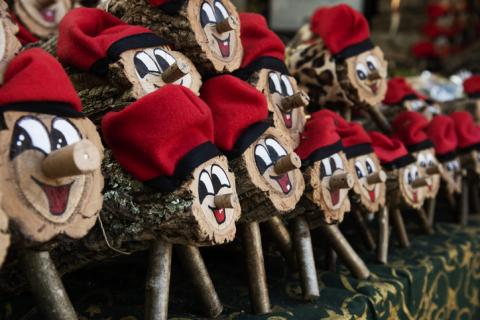I remember my first holiday season away from home. I was 22 and had just moved to Peru as part of a two-year volunteer programme. Though I was staying with a host family and had a beautiful experience of celebrating traditional Peruvian customs with them, part of me still missed my own family.
Fast forward seven years, and I find myself in the second year of my graduate programme in Barcelona, Spain. Though I am now more used to being away from home than I was then, and love living abroad, something is still irreplaceable about the holiday season in my home country of the US – from Halloween, through Thanksgiving, to Christmas.
Saying that, I live in an area of Spain with many of its own rich traditions. For those who don’t know, Barcelona is situated in Catalonia (Catalunya in Catalan) – an autonomous region with its own language, history, culture and customs.
The holiday season in Barcelona starts on All Saints’ Day (1 November), with a celebration called the Castanyada. The tradition originated more than 300 years ago as a funerary festival that combined pagan and Christian traditions.
During this time, pop-up stands around the city sell roasted chestnuts and sweet potatoes on the street, and bakeries fill their display windows with various flavours of panellets (a sweet treat made with marzipan and pine nuts).
My university organises activities for this holiday, too. Through a programme for international students, such as myself, called Voluntariat Lingüístic (VL), last year I had the opportunity to travel to a Catalan pueblo outside the big city, where we toured an old church and then roasted castañas (chestnuts) and ate panellets in a park nearby.
One of the most prominent centrepieces of a Catalan Christmas is the Tió de Nadal (otherwise known as the “Christmas trunk” or, in other regions of Spain, the “Christmas log”). In the US, houses might be decorated with Santa figurines; here it is common to display a log, complete with a face marked on one of the cut ends, wearing a red Santa-like hat and draped with a red blanket over its two front “legs”.
The tradition has its roots in celebrations honouring nature and fertility during the winter solstice. It developed into a homage to the logs burned during the winter to keep houses warm. Today, children are in charge of caring for the Tió during December – keeping it warm, “feeding” it, etc. Children also sing to the log while tapping it rhythmically with sticks.
International perspective: an Indian student in Spain
The 10 most beautiful universities in Europe
The 10 most beautiful university libraries in the world
The VL programme allows students to celebrate these traditions. A week before the end of term, the group organises a trip to visit the Cathedral of Barcelona (where the city’s main nativity scene is housed) before a stroll around the Fira de Santa Llúcia, the city’s oldest Christmas market (which dates back to 1786).
Afterwards, students are taken to the Mercat de Santa Caterina to learn about traditional holiday dishes such as meat-filled cannelloni eaten on Sant Esteve (St Stephen’s Day), the holiday celebrated the day after Christmas. The outing closes with an opportunity to sing and tap the Caga Tió ourselves, to see what gifts it will grant us, while sipping on cava (a Champagne-like drink emblematic of the region).
And, lastly, Catalunya celebrates one more important holiday to welcome in the new year – Three Kings Day, which is celebrated on 6 January. Although, with globalisation, many families exchange gifts on Christmas Day, in Catalunya traditionally gifts are exchanged on Día de los Reyes Magos. The city celebrates the day with a procession, where the “kings” throw gifts and sweets to the crowd.
All these distinct traditions make celebrating the holiday season here in Catalunya a unique experience, but spending these weeks (or months) away from home and your own festivities can still be challenging (especially if it is your first time away from your family).
My most important piece of advice would be: don’t be afraid to reach out to others. No matter where you study abroad, and no matter the customs celebrated in your location or back in your home country, the most important thing about this time of year is to share.
Ask friends from the area if you can celebrate a holiday with them – most people will be excited to share their customs with you. Otherwise, organise a celebration of your own unique customs as well as those of the other international students around you. No one will say no to sharing food and drink! Holidays away from home can feel lonely, but it is a rare experience to share traditions with others while learning about new ones.
For example, Thanksgiving is a holiday celebrated in my own country that does not have a Catalan equivalent. However, Catalan and foreign friends alike organised a day to celebrate the custom with me, complete with traditional dishes for all dietary requirements. It might not be the same as celebrating with my own family, but it was a beautiful experience to share with others in my new (or temporary) “home away from home”.

Comments